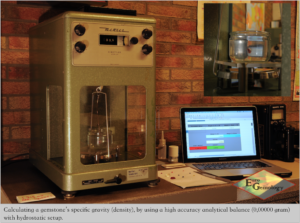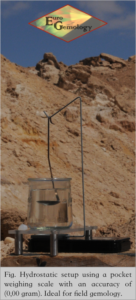 The specific gravity or density of gemstone belongs to the key features of diagnostic gemology. The specific gravity becomes a vital information when dealing with gemstone where the refractive index is above 1.81 or rough gemstones in their natural forms. For this reason it is necessary to work with high precision and making an average of three test results. Obviously the quality of your analytical balance plays a great role as well. It is advisable to use an analytical balance with an accuracy of 0,0000(0) gram, especially when you are dealing with gemstones smaller than 0,5 ct. Beware that working with such a high accuracy balance requires experience and discipline, as there are many factors that have influence on the quality of your test results. The following factors such as: fluctuating external temperature, pressure changes, water purity, surface tensions, gemstone’s porosity etc, could have a negative influence on your results.
The specific gravity or density of gemstone belongs to the key features of diagnostic gemology. The specific gravity becomes a vital information when dealing with gemstone where the refractive index is above 1.81 or rough gemstones in their natural forms. For this reason it is necessary to work with high precision and making an average of three test results. Obviously the quality of your analytical balance plays a great role as well. It is advisable to use an analytical balance with an accuracy of 0,0000(0) gram, especially when you are dealing with gemstones smaller than 0,5 ct. Beware that working with such a high accuracy balance requires experience and discipline, as there are many factors that have influence on the quality of your test results. The following factors such as: fluctuating external temperature, pressure changes, water purity, surface tensions, gemstone’s porosity etc, could have a negative influence on your results.
A pocket weighing balance or mini scale with an accuracy of 0,00 gram with hydrostatic weighing setup can be used to determine the specific gravity of a gemstone on condition that the user is very experienced. As this setup can be easily transported, it is best used for fieldwork and rather not when it concerns small gemstones. As the accuracy is limited, these results should also not be used as a diagnostic feature on a research report.
Some typical factors that could cause aberrations of a gemstone’s specific gravity
- Air bubbles stuck to the gemstones surface, (watch out for very small gemstones!)
- Hidden cavities (drilled pearls and beads)
- Porous gemstones, (they can absorb water)
- Foreign substance, such as oil or very small dirt particles attached to small gemstones.
- Treated gemstones
- Doublets or triplets
- Etc…
The smallest air bubble could cause your specific gravity to be altered, the smaller the gemstone the greater your aberration will be.
Hidden cavities can hold air, here again causing the specific gravity to be altered.
Usually the specific gravity is an indicative feature, but in some cases the test results can almost be diagnostic (e.g. diamond, corundum, quartz, danburite …).
When using analytical balances to measure and calculate specific gravity of gemstones for commercial purposes, verify local laws and regulations concerning the calibration of your balance!
Calculating Specific Gravity of a Small Gemstone
In handling a 0,178 ct gemstone with refractive index above 1,81 the specific gravity becomes a very important feature to diagnose. As the gemstone is so small it requires several measurements. Procedure of study is as follows:
- Clean the gemstone.
- Clean the gemological tweezers.
- Observe both with loupe/hand lens and make sure no dust particles are attached.
- Boil water and let it cool down.
- Add smallest amount of detergent to break surface tension, this procedure is very important witch such small gemstones. (Touch detergent with finger then touch the water)
- Stir your density pan in the prepared water and observe if there are no air bubbles attached.
- Mount density pan and partly submerge it in water (there are different hydrostatic weighing setups)
- Observe the pan again for air bubbles, in case you observe any air bubbles, slightly tap it with tweezers until they are all gone.
- (In case you don’t have a TARE function, weigh your density pan and later subtract it from your mass in air and your mass in water)
- Weigh the gemstone in air, close side window(s) of the analytical balance and make sure that not the slightest air movement can enter the weighing compartment.
- During the weighing in air, don’t move and do not lean on the table where the weighing device is placed. Write down the result.
- Now it is time to weigh the gemstone in water, again observe no air bubbles are attached to the density pan submerged in water.
- Stir the gemstone in water and gently drop it in the submerged density pan. Now observe very well that no air bubbles are attached to the gemstone, if so repeat the stirring process.
- Weigh the gemstone in water, close side window(s) of the analytical balance and make sure that not the slightest air movement can enter the weighing compartment.
- During the weighing in water, again don’t move and do not lean on the table where the weighing device is placed. Write down the result.
- Remove gemstone out of the water, immediately dry the gemstone and tweezers very thoroughly.
- Calculate the gemstone’s volume.
- Apply formula to calculate the specific gravity. (Mass in air/ Volume)
- Repeat all these steps two more times and make an average of all the results.
This might seem to be a very demanding process or work structure but working with such a high precision is necessary for separating certain gemstones where specific gravity ranges are almost the same or even overlapping. Extra care has to be taken when dealing with porous gemstones as they can absorb water, this can be observed in some cases when mass in water keeps changing on the scale.



